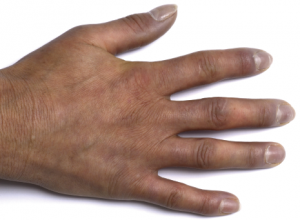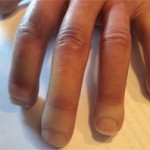That night Dr. Indura crashed. Her lungs filled with fluid; her oxygen levels plummeted, and when I made my early morning rounds, I heard the oddly reassuring metronome of the ventilator before I pulled open the curtain to her room: shhk, shhtk, shhk. At the head of the bed, a surgical resident draped sterile towels over her neck and right shoulder in preparation for inserting a dialysis catheter. I went out to talk with her husband.
He was alone in the family room, his face in his hands, eyes puffy and bloodshot. I sat down, saying nothing.
“Medsger?” he asked finally. “Is he around yet this morning?”
“No. Not yet. It’s 6:00 a.m. He usually rounds by 7:00,” I replied.
Mr. Indura nodded almost imperceptibly. I offered him a Snickers bar. He waved me off, but the eccentricity of the offer appealed to him, and he sat up and unwrapped the bar. We ate our Snickers bars together in silence. It seemed to revive him. “I’ve been reading about scleroderma,” he said finally. “Why Michelle? We don’t use chemicals on our lawn. Our backyard backs up onto a national forest. She eats right, doesn’t smoke or do drugs, works like a dog, great mother,” his voice cracked. “Great wife, I mean not that people deserve a friggin’ deadly disease because they treat their body like a sewer pipe.”
“I know, it doesn’t make sense,” I agreed.
“She’s like Job. Just when she’s adjusted to a new challenge, there’s something new. Every inch of her body seems like it’s inflamed. And inside, her bowel, the lung, the kidneys, I feel like she’s rotting away. And for what? Is this some sort of cosmic punishment?”
Immunopathology of Scleroderma

This image shows the hand of a 34-year-old woman with scleroderma and skin hardening on her fingers. Source: SPL/Science Source
That morning, I attended our weekly rheumatology research conference. The topic: The immunopathology of diffuse scleroderma. Over the green expanse of three blackboards, arrows and lines connected the up-regulatory and down-regulatory pathways leading to excess production of collagen by fibroblasts and overgrowth of vascular endothelial cells. I noticed that the board was full of question marks linking the proposed pathways. Various cytokines were presented as a rogue’s gallery of potential triggers or perpetuators of the disease: transforming growth factor B (TGF-B), platelet-activating factor (PAF), endothelial growth factor 1 (EGF-1), fibroblast-activation factor (FAF), interleukin 1. It was suggested that several could be targeted for novel drug studies.



